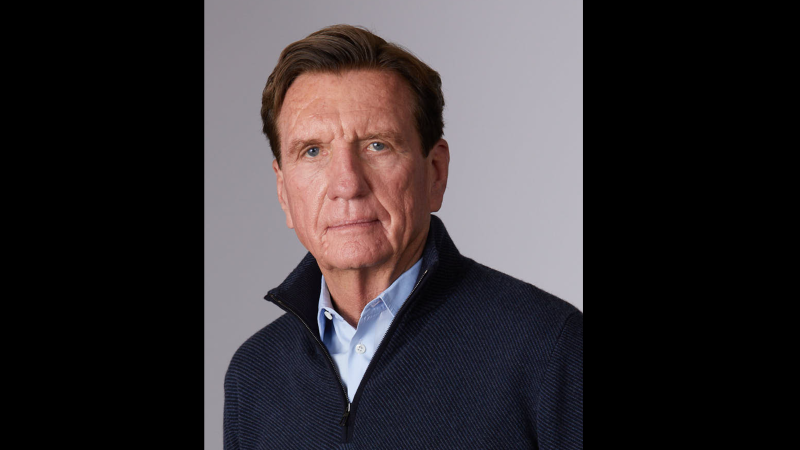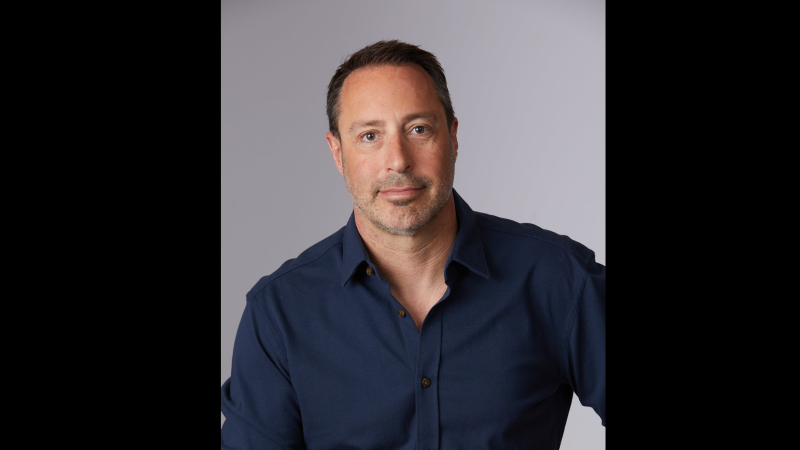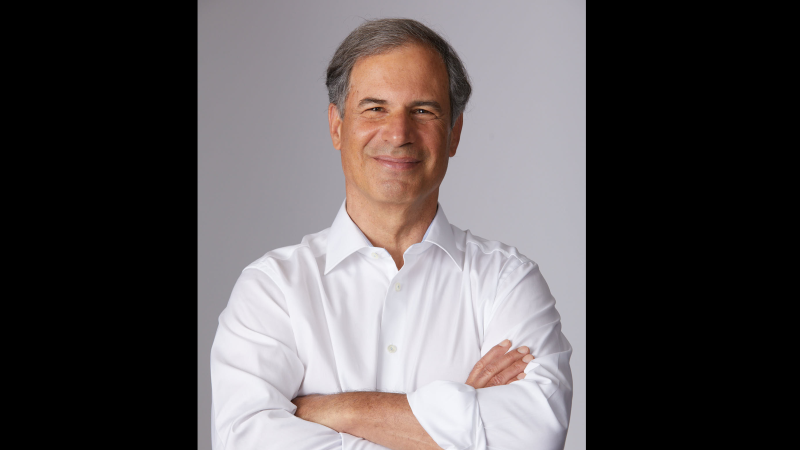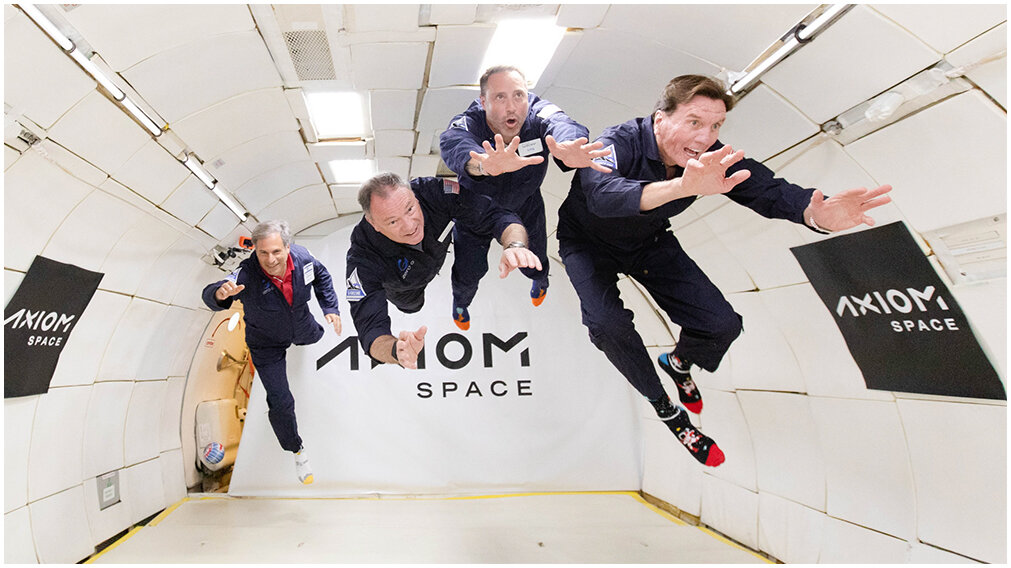Axiom Space Ax-1 mission: The first all-private crew to the International Space Station
The launch sent a SpaceX Crew Dragon to orbit April 8, for a 10-day International Space Station mission.
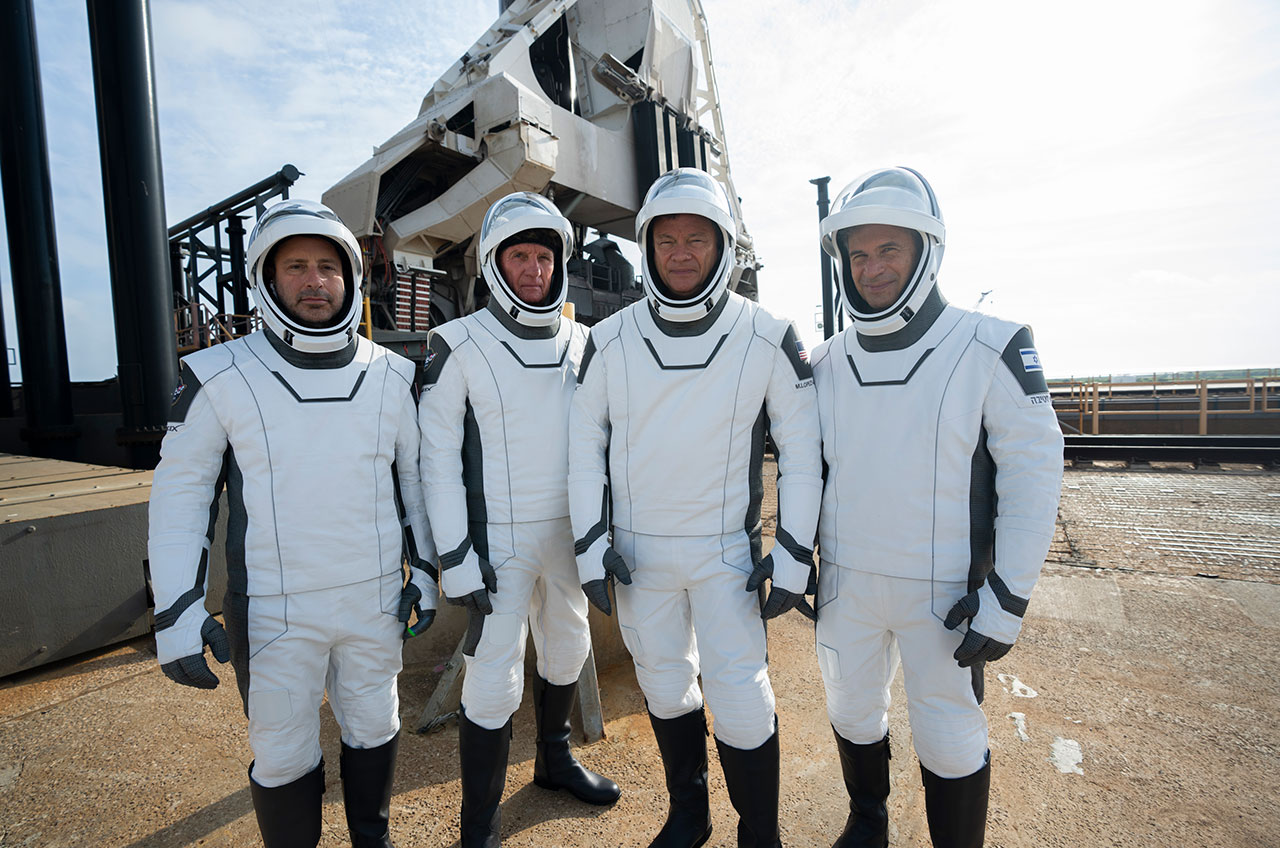
Axiom Mission 1 was a mission to the International Space Station by the Houston-based Axiom Space that marked the first fully private crew to the orbiting complex. It launched on April 8, 2022.
SpaceX launched a four-person crew on the mission that included a former NASA astronaut and three paying spaceflyers. The four space travelers aimed to distinguish themselves as much as possible from space tourists by performing experiments and research on the International Space Station. The mission was originally scheduled to last 10 days, but was extended to 17 days due to bad weather at the crew's splashdown site.
Axiom Space plans to run additional missions to the space station in the coming years before aiming to send up its own module in 2024, which will also be used as a movie studio and experiments. Read below to find out more about the Axiom Space 1 mission and how that work fits into NASA's and Axiom Space's plans.
What time was the Axiom Space 1 launch?
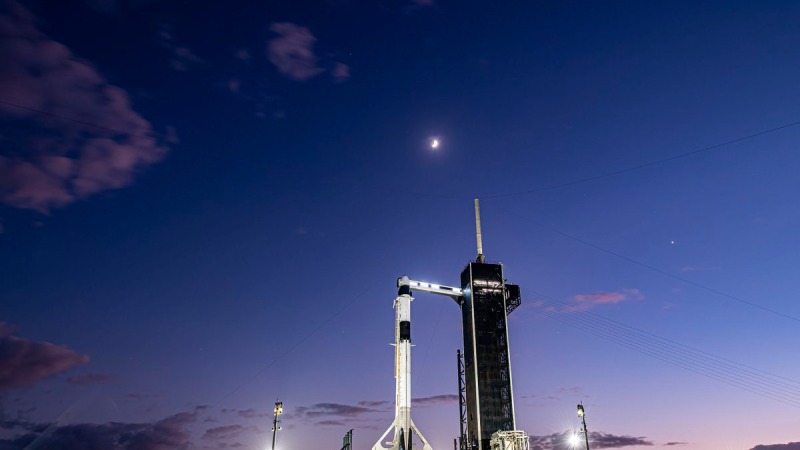
Axiom Mission 1 (also known as Ax-1) launched April 8 at 11:17 a.m. EDT (1517 GMT) from Pad39A of NASA's Kennedy Space Center, Florida. The liftoff was originally scheduled to launch on April 3, but was delayed to April 8 for unstated reasons by Axiom Space and SpaceX that may have been related to delays with NASA's Artemis 1 moon rocket fueling test at the nearby Pad 39B.
The mission used a SpaceX Crew Dragon spacecraft and Falcon 9 rocket, both operated by SpaceX. The California company uses the same spacecraft-rocket system to launch human missions to the ISS for NASA's Commercial Crew program.
SpaceX leases Launch Complex 39A from NASA for its human missions, and Axiom Space was the company's sixth crewed mission to launch from this pad. The Falcon 9's first stage is fully reusable, and landed shortly after launch on a drone ship stationed in the Atlantic Ocean.
The four spaceflyers arrived at the ISS on April 9, with their Dragon capsule docking at the forward port of the United States Harmony module, also known as Node 2. While Ax-1 joined Expedition 66 spaceflyers from several nations, Axiom ran its own independent mission of research and exploration, including several experiments.
Breaking space news, the latest updates on rocket launches, skywatching events and more!
Following an undocking from Harmony, Ax-1 and its four crewmembers splashed down in the Atlantic Ocean on April 17.
Who launched on the Axiom Space 1 mission?
Michael López-Alegría

Michael López-Alegría commanded the mission. The former NASA astronaut is vice-president of business development for Axiom Space. López-Alegría has flown four times in space already on space shuttle missions STS-73, STS-92, and STS- 113; he was also the commander of the ISS Expedition 14, coming to and from the space station aboard a Russian Soyuz TMA-9.
As of this writing, López-Alegría holds the record for the most extravehicular activities (spacewalks) ever performed, at 10 different excursions. He also has the most accumulated time in a spacesuit, at 67 hours and 40 minutes. His various NASA achievements earned him an induction in the U.S. Astronaut Hall of Fame in 2020.
López-Alegría is a former president of the Commercial Spaceflight Federation, a former member of the Human Exploration and Operations Committee of the NASA Advisory Council, and former part of the Commercial Space Transportation Advisory Committee to the Federal Aviation Administration. Another of his many affiliations is past president of the Association of Space Explorers USA.
Larry Connor
Larry Connor was the pilot of Ax-1. He has experience in more than 16 different aircraft and fighter jets, as well as helicopter time.
Connor's industry accolades include winning five aerobatic competitions and participating in several U.S. National Aerobatic Championships. He also is familiar with racecar driving, a high-speed sport demanding careful attention and procedures, much like in spaceflight. He has racked up 70 race wins in different vehicle types.
Connor's The Connor Group is for real estate and technology investment and has a reported $3.3 billion in assets under management. It focuses on luxury apartment communities and has won several industry awards. He also co-founded two financial technology companies, such as First Billing Services.
On the philanthropic side, Connor also founded The Connor Group Kids & Community Partners, with an aim to address generational poverty. The group plans to spend $300 million in non-profit work in the next decade.
Mark Pathy
Mark Pathy, a mission specialist on Ax-1, is CEO and chair of MARVIK of Montreal, Canada. MARVIK performs investments in firms that focus on innovation, entrepreneurship and "responsible investing" in areas focused on food, agriculture, environmental sustainability and social responsibility.
Pathy is also chair of the board of Stingray Group Inc., a publicly traded music, media and technology company that is also in Montreal. His previous affiliations include president and CEO of dry bulk shipping company Fednav International, and co-CEO of the parent company of Fednav (called Fednav Ltd.)
For philanthropy, Pathy is on the board of the Pathy Family Foundation. He is also a member of the boards and executive committees of the Montreal Children's Hospital Foundation, along with homeless youth support organization Dans la Rue ("On the Street.")
Eytan Stibbe
Eytan Stibbe, a mission specialist on Ax-1, is the founding partner of the Vital Capital impact investment fund that focuses on opportunities in under-resourced countries, such as some nations of Africa. The fund focuses on companies seeking gains in social and environmental metrics, along with a competitive financial return.
A selection of Stibbe's international work includes member of the World Economic Forum, member of the advisory committee of impact investment fund Bridges Israel, and (with his wife, Ora) founding and supporting the social benefit company Anatta and central Israel's Human Spirit Treatment Center that subsidizes mental health treatment.
Stibbe is a former fighter pilot for the Israel Air Force (IAF) and flight instructor at the Israel Air Force Flight Academy, flying thousands of flights and numerous aircraft types. He also participated in the 1991 Gulf War under Ilan Ramon, who later went on to become Israel's first astronaut; the two became close friends.
Ramon died during the Columbia space shuttle accident of 2003, along with six space shuttle crewmates. Following the death of Ramon's son Asaf in 2009 during an IAF training accident, Stibbe and members of the Ramon family were among the co-founders of the Ramon Foundation (which promotes academic excellence in aviation and space). Stibbe still serves on its board of directors.
What did the Axiom Space 1 mission do?
Axiom was the first all-private mission to fly to the ISS. The crew is distinct from a handful of "space tourists" who visited the space station as individuals over the complex's history, with California millionaire Dennis Tito being the first to do so in 2001. (For context, the ISS coalition began allowing professional crews to host long-duration missions there only the year before, in 2000.)
This first crew, Ax-1, had an ambitious research agenda in mind that will not be focused on having the members "paste their nose on the window," Michael Suffredini, president and CEO of Axiom, told reporters during a press conference in late February 2022. Over eight days, the crew aimed to perform 25 experiments to focus on science, education and outreach, including human health, Axiom has said.
Connor performed his experiments in collaboration with the Mayo Clinic and Cleveland Clinic, with whom he worked with for most of the past decade. Through MRIs and in-space experiments, he aimed to track heart health and senescent cells, meaning cells that have stopped dividing.
Pathy was working on behalf of the Montreal Children's Hospital, Canadian Research Universities and the Royal Canadian Geographical Society. His various experiments included studying mixed reality technology, sleep disturbances, chronic pain, radiation exposure, isolation, and changes to eye shape in space. A portion of his work will be educational activities, especially discussing the environment around the Great Lakes.
Stibbe worked on behalf of the Ramon Foundation and in collaboration with the Israel Space Agency in the Israeli Ministry of Innovation, Science, and Technology. He planned scientific, educational and artistic activities with younger people in Israel and around the world, including components concerning peace, innovation and social responsibility. His-wide ranging experiments touch fields as diverse as astrophysics, optics, healthcare and communication, among many others.
What is next for Axiom Space?
Axiom eventually wants to build a commercial space station in orbit, but it is going to be doing so in gradual increments. Its plan is to launch several modules to the ISS that will eventually detach as a group, operating on its own to do research in low Earth orbit.
The plan is to send the first module up in September 2024, and then to deliver three more modules by the end of 2027 if the schedule holds.
"With the delivery of the fourth module, Axiom Station will have the capability to be independent of the ISS and can then separate to become an independent, next-generation space station with upgraded crew quarters, increased payload capacity and a dedicated manufacturing and research lab module," Axiom chief technology officer Matt Ondler told Space.com.
The ISS has an operational approval to last through the end of 2024; there has been some discussion of extending it to 2030, which NASA would very much like to do. U.S. President Joe Biden recently committed to 2030, but the other ISS partners — for example, the European Space Agency, the Canadian Space Agency, the Japan Aerospace Exploration Agency and Russia's federal space corporation, Roscosmos — need to sign on as well.
Relations were recently complicated by international sanctions induced on Russia due to that country's invasion of Ukraine in February 2022. ISS operations are going normally for now, but Russia and its partners have been severing ties on other space projects and it is unclear what the long-term implications for the space station would be.
Axiom joins several other companies planning to create commercial outposts in low Earth orbit, seeking out opportunities for tourism, manufacturing, microgravity research and product development, Ondler said. He added a commercial space station like Axiom's "offers cost-saving opportunities" as NASA and other countries seek to expand their research to other worlds, such as the moon or Mars.
Bibliography
"Axiom is flying history’s first private ISS mission." Axiom Space. (2022). https://www.axiomspace.com/ax1
"Axiom Space mission updates." Axiom Space. (2022.) https://www.axiomspace.com/missionupdates
"Axiom Space reveals robust microgravity research portfolio for first-ever private mission to visit International Space Station." Axiom Space. (2021, November 17.) https://www.axiomspace.com/press-kit-ax1-research
"The history and timeline of the ISS." ISS National Laboratory. (2022.) https://www.issnationallab.org/about/iss-timeline/
"NASA selects first commercial destination module for International Space Station." NASA. (2020, Jan. 27). https://www.nasa.gov/press-release/nasa-selects-first-commercial-destination-module-for-international-space-station
Follow Elizabeth Howell on Twitter @howellspace. Follow us on Twitter @Spacedotcom and on Facebook.

Elizabeth Howell (she/her), Ph.D., was a staff writer in the spaceflight channel between 2022 and 2024 specializing in Canadian space news. She was contributing writer for Space.com for 10 years from 2012 to 2024. Elizabeth's reporting includes multiple exclusives with the White House, leading world coverage about a lost-and-found space tomato on the International Space Station, witnessing five human spaceflight launches on two continents, flying parabolic, working inside a spacesuit, and participating in a simulated Mars mission. Her latest book, "Why Am I Taller?" (ECW Press, 2022) is co-written with astronaut Dave Williams.
